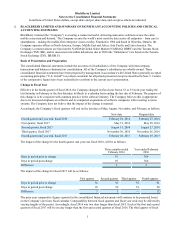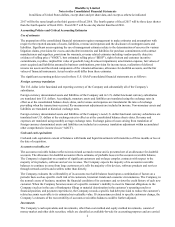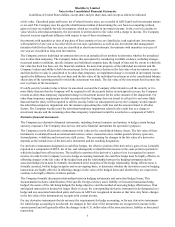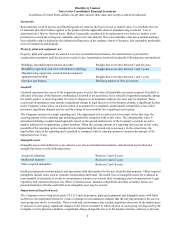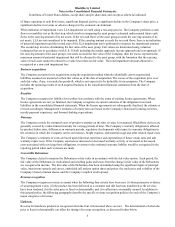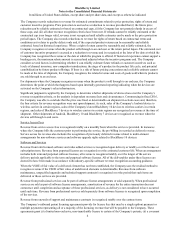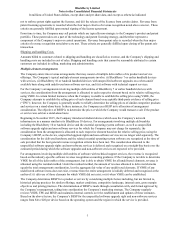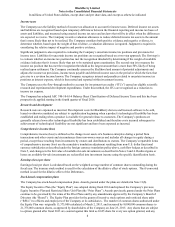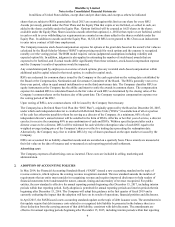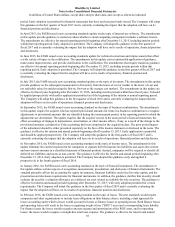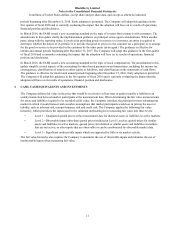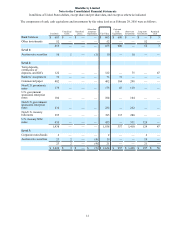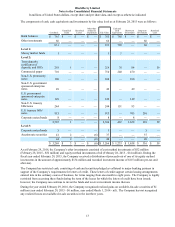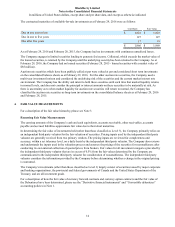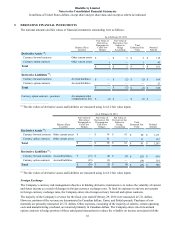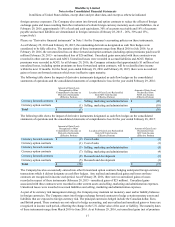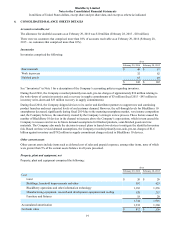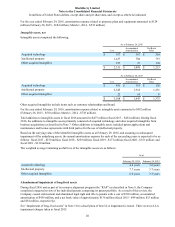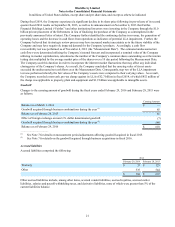Blackberry 2016 Annual Report Download - page 79
Download and view the complete annual report
Please find page 79 of the 2016 Blackberry annual report below. You can navigate through the pages in the report by either clicking on the pages listed below, or by using the keyword search tool below to find specific information within the annual report.BlackBerry Limited
Notes to the Consolidated Financial Statements
In millions of United States dollars, except share and per share data, and except as otherwise indicated
11
periods beginning after December 15, 2018. Early adoption is permitted. The Company will adopt this guidance in the
first quarter of fiscal 2020 and is currently evaluating the impact that the adoption will have on its results of operations,
financial position and disclosures.
In March 2016, the FASB issued a new accounting standard on the topic of revenue from contracts with customers. The
amendments in this update clarify the implementation guidance on principal versus agent considerations. When another
party, along with the reporting entity, is involved in providing goods or services to a customer, an entity is required to
determine whether the nature of its promise is to provide that good or service to the customer (as a principal) or to arrange
for the good or service to be provided to the customer by the other party (as an agent). The guidance is effective for
interim and annual periods beginning after December 15, 2017. The Company will adopt this guidance in the first quarter
of fiscal 2019 and is currently evaluating the impact that the adoption will have on its results of operations, financial
position and disclosures.
In March 2016, the FASB issued a new accounting standard on the topic of stock compensation. The amendments in this
update simplify several aspects of the accounting for share-based payment award transactions, including the income tax
consequences, classification of awards as either equity or liabilities, and classification on the statements of cash flows.
The guidance is effective for interim and annual periods beginning after December 15, 2016. Early adoption is permitted.
The Company will adopt this guidance in the first quarter of fiscal 2018 and is currently evaluating the impact that the
adoption will have on its results of operations, financial position and disclosures.
3. CASH, CASH EQUIVALENTS AND INVESTMENTS
The Company defines fair value as the price that would be received to sell an asset or paid to transfer a liability in an
orderly transaction between market participants at the measurement date. When determining the fair value measurements
for assets and liabilities required to be recorded at fair value, the Company considers the principal or most advantageous
market in which it would transact and considers assumptions that market participants would use in pricing the asset or
liability, such as inherent risk, non-performance risk and credit risk. The Company applies the following fair value
hierarchy, which prioritizes the inputs used in the valuation methodologies in measuring fair value into three levels:
• Level 1 - Unadjusted quoted prices at the measurement date for identical assets or liabilities in active markets.
• Level 2 - Observable inputs other than quoted prices included in Level 1, such as quoted prices for similar
assets and liabilities in active markets; quoted prices for identical or similar assets and liabilities in markets
that are not active; or other inputs that are observable or can be corroborated by observable market data.
• Level 3 - Significant unobservable inputs which are supported by little or no market activity.
The fair value hierarchy also requires the Company to maximize the use of observable inputs and minimize the use of
unobservable inputs when measuring fair value.


